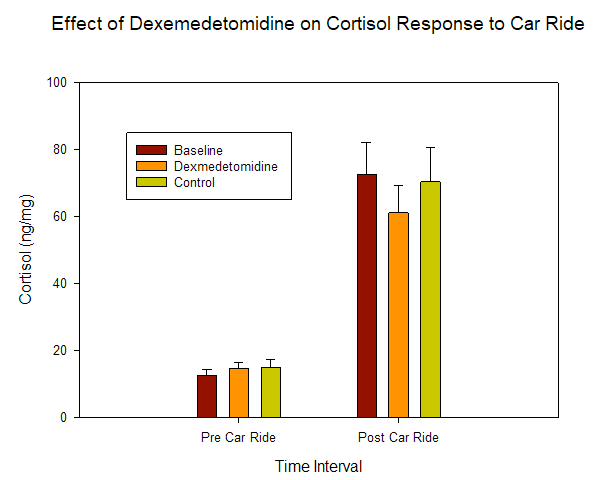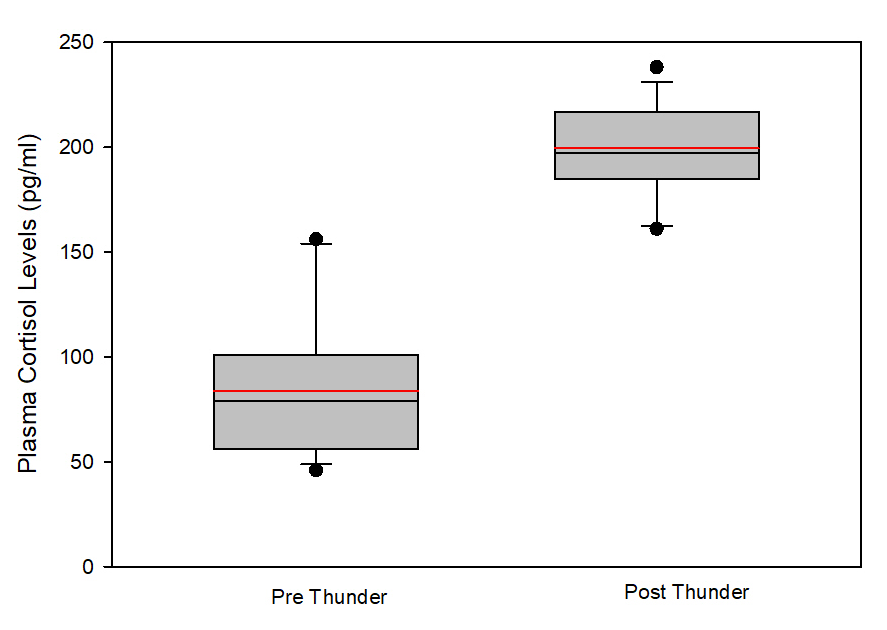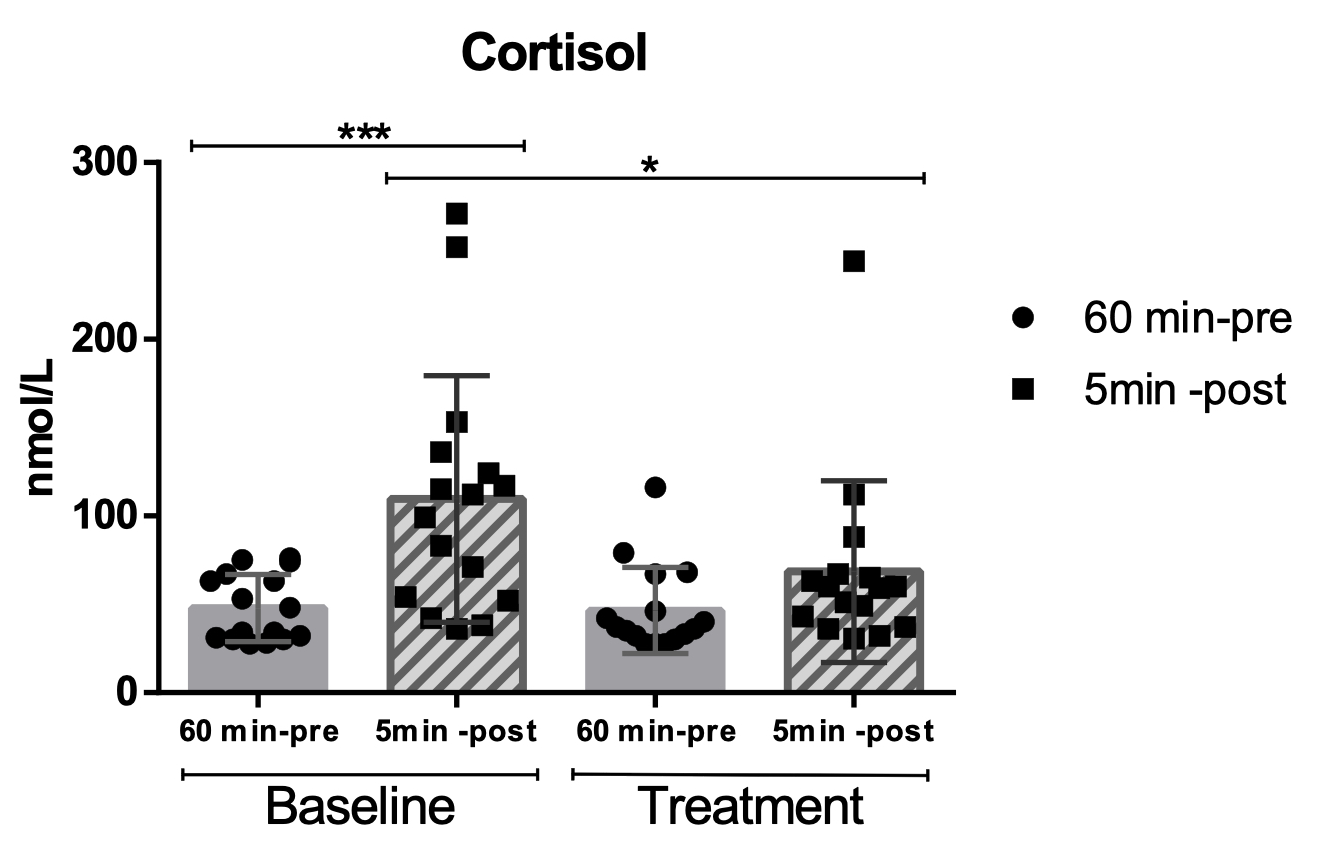 Anxiety Models
Anxiety Models
To date, there are few approved therapeutic options for dogs with situational (state) fear and anxiety, and scientific evidence of benefits is typically weak. Our laboratory models of travel and noise induced (thunder) fear and anxiety, provide standardized procedures for pre-clinical assessment of therapeutic interventions. 1-11
Noise-induced Anxiety
Thunderstorm Model
The thunder storm model entails placing, dogs individually into an open field room for 9 minutes where it receives exposure to 3 minutes of a taped recording of thunder. Assessment measures include activity (hyper and hypo), a global observational ranking on fear and anxiety, blood cortisol and heart rate. The model has been validated with diazepam and imepitoin as positive controls. See figures 1 and 2 below.
Travel-induced Anxiety
In the travel model we assess frequency of individual stress and anxiety induced behavioural and physiological responses over the course of a 10- minute travel route. Measures include heart rate, post-car ride cortisol, body position (standing, sitting, lying down) and both direct (real-time) and video behavioral observation.
Cortisol, heart rate and lip licking are the most frequently and consistently increased in response to stress10-13, each of which has been demonstrated to be reduced with anxiolytic therapeutic interventions10,11. (See Figure 3) While other behavioural signs of stress are observed more variably between individuals, panting, yawning and standing may decrease and lying increase as stress is decreased.11,13,14,15

- Landsberg GM, Mougeot I, Kelly S, Milgram NW. Assessment of Noise Induced Fear and Anxiety in Dogs: Modification by a Novel Fish Hydrolysate Supplemented Diet. J Vet Behav. 2015;10:391-398
- Engel O, Masic A, Landsberg G, Brooks M, Mills DS, Rundfeldt C. Imepitoin shows benzo-diazepine-like effects in models of anxiety. Front. Pharmacol 2018, doi.org/10.3389/fphar.2018.01225
- Masic A, Landsberg G, Milgram B et al. Efficacy of Souroubea-Platanus Dietary Supplement Containing Triterpenes in Beagle Dogs Using a Thunderstorm Noise-Induced Model of Fear and Anxiety. Molecules 2021, 26, 2049. https://doi.org/10.3390/ molecules26072049
- Landsberg G, Huggins S, Fish J et al. The effects of a nutritional supplement (Solliquin) in reducing fear and anxiety in a laboratory model of thunder induced fear and anxiety. Abstract: In Denenberg S (ed). Proc 11th International Veterinary Behaviour Meeting, CABI: Oxfordshire, 2017; 94-97
- Landsberg GM, Beck A, Lopez A, Deniaud M, Araujo JA, Milgram NW. Dog appeasing pheromone collars reduce sound-induced fear and anxiety in Beagle dogs: a placebo-controlled study. Vet Rec. 2015; 10, 391-398
- Gruen ME, Case BC, Foster ML, Lazarowski L, Fish RE, Landsberg GM, DePuy V, Dorman DC, Sherman BL. The use of an open field model to assess sound-induced anxiety associated behaviors in Labrador Retrievers. J Vet Behav 2015, 10, 338-345
- Milgram NW, Landsberg GM, Snow B. Anxiety reducing effectiveness of Calmz® Anxiety Relief System in beagle dogs in a modified thunderstorm model. ACVB/AVSAB Vet Behav Symposium Denver, 2014, 29-30
- Araujo JA, de Rivera C, Landsberg GM, Adams PE, Milgram NW. Development and validation of a novel laboratory model of sound-induced fear and anxiety in Beagle dogs. J Vet Behav 2013;8:204-12
- DePorter T, Landsberg GM, Araujo JA, Ethier JL, Bledsoe DL. Harmonease Chewable Tablets reduces noise-induced fear and anxiety in a laboratory canine thunderstorm simulation; a blinded and placebo-controlled study. J Vet Behav 2012; 7, 225-232
- Landsberg G, Mougeot I, Kosziwka W et al. Development and validation of a dog travel anxiety model. Abstract: In Proc 12th International Veterinary Behaviour Meeting. Washington, D.C. IVBM, Upton, UK. 2019; 21-23
- Landsberg GM, Araujo JA, Fish J, Thevarkunnel S. Assessing stress in laboratory dogs to car rides and rehousing. Abstract: Proc 1st ECVBMAW, Berlin, 2018, 367-269
- Mougeot I, Dunn D, Landsberg G et al. Effect of a botanical-blend on mild car ride induced anxiety in laboratory dogs. Proc 1st European Congress of Veterinary Behavioural Medicine and Animal Welfare. DVG Publishing; Berlin 2018, 286-287
- Herbel J, Aurich J, Gaultier C et al. Stress response of beagle dogs to repeated short distance road transport. Animals 2020; 10, 2114.
- Amat M, Le Brech S, Garcia-Marato C et al. Preventing travel anxiety using dexmedetomidine hydrochloride oro-mucosal gel. In Denenberg S (ed). Proc 11t International Veterinary Behaviour Meeting, CABI Oxfordshire UK, 2017; 20-21
- Frank D, Gauthier A, Bergeron R. Placebo-controlled double-blind clomipramine trial for the treatment of anxiety or fear in beagles during ground transport. Can Vet J 2006; 47, 1102–1108

